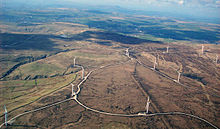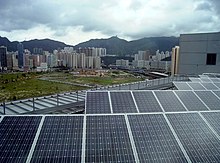Selected article 1
Portal:Energy/Selected article/1
The 1973 oil crisis began in earnest on October 17, 1973, when the members of Organization of Arab Petroleum Exporting Countries announced, as a result of the ongoing Yom Kippur War, that they would no longer ship petroleum to nations that had supported Israel in its conflict with Syria and Egypt (i.e., to the United States and its allies in Western Europe).At about the same time, OPEC members agreed to use their leverage over the world price-setting mechanism for oil in order to quadruple world oil prices, after attempts at negotiation failed. Due to the dependence of the industrialized world on OPEC oil, these price increases were dramatically inflationary to the economies of the targeted countries, while at the same time suppressive of economic activity.
This increase in the price of oil had a dramatic effect on oil exporting nations, for the countries of the Middle East who had long been dominated by the industrial powers were seen to have acquired control of a vital commodity. The traditional flow of capital reversed as the oil exporting nations accumulated vast wealth. Meanwhile, the shock produced chaos in the West, and shares on the New York Stock Exchange lost $97 billion in value in six weeks.
Selected article 2
Portal:Energy/Selected article/2
Photovoltaics (PV) is a method of generating electrical power by converting solar radiation into direct current electricity using semiconductors that exhibit the photovoltaic effect. Photovoltaic power generation employs solar panels composed of a number of cells containing a photovoltaic material. Due to the growing demand for renewable energy sources, the manufacturing of solar cells and photovoltaic arrays has advanced considerably in recent years.Solar photovoltaics is growing rapidly, albeit from a small base, to a total global capacity of 40,000 MW at the end of 2010. More than 100 countries use solar PV. Installations may be ground-mounted (and sometimes integrated with farming and grazing) or built into the roof or walls of a building (building-integrated photovoltaics).
Driven by advances in technology and increases in manufacturing scale and sophistication, the cost of photovoltaics has declined steadily since the first solar cells were manufactured. Net metering and financial incentives, such as preferential feed-in tariffs for solar-generated electricity, have supported solar PV installations in many countries.
Selected article 3
Portal:Energy/Selected article/3
The internal combustion engine is widely used to power a great variety of vehicles and other devices. It is an engine in which the burning of a fuel occurs in a confined space called a combustion chamber. This exothermic reaction of a fuel with an oxidizer creates gases of high temperature and pressure, which are permitted to expand.The defining feature of an internal combustion engine is that useful work is performed by the expanding hot gases acting directly to cause movement, for example by acting on pistons, rotors, or even by pressing on and moving the entire engine itself.
Internal combustion engines are most commonly used for mobile propulsion systems, where their high power-to-weight ratios, together with excellent fuel energy-density, are advantageous. They have appeared in almost all automobiles, motorbikes, many boats, and in a wide variety of aircraft and locomotives. Where very high power is required, such as jet aircraft, helicopters and large ships, they appear mostly in the form of gas turbines. They are also used for electric generators and by industry.
The most common fuels in use today are hydrocarbons derived from petroleum including diesel, gasoline and liquified petroleum gas. Most internal combustion engines designed for gasoline can run on natural gas or liquified petroleum gases without modifications except for the fuel delivery components. Liquid and gaseous biofuels, including ethanol and biodiesel can also be used, and trials of hydrogen fuel have been in progress for some years.
Selected article 4
Portal:Energy/Selected article/4
In 2004, the worldwide energy consumption of the human race was on average 15 terawatts (TW; 1 TW = 1 x 1012 W) with 86.5% from burning fossil fuels. This is equivalent to 471,000 PJ (1 PJ = 1 x 1015 J) per year. There is at least 10% uncertainty in these figures due to national variations in tracking consumption, and due to variations in energy content between particular barrels of oil or tons of coal.The remaining worldwide energy resources are large, with the remaining fossil fuels totaling an estimated 0.4 YJ (1 YJ = 1024 J) and the available nuclear fuel such as uranium exceeding 2.5 YJ (1 YJ = 1024 J). Mostly thanks to the Sun, the world also has a renewable usable energy flux that exceeds 120 PW (8,000 times 2004 total energy usage), or 3.8 YJ/yr, dwarfing all non-renewable resources.
Despite the abundance of fossil fuels there are a number of pressures that may move the world’s energy consumption to alternative energy sources. These include political considerations over energy security and potential pressure from energy superpowers, environmental concerns related to global warming and sustainability, and economic pressure resulting from energy price rises, carbon emissions trading and green taxation.
This move is already starting to happen in some countries, notably as a result of the Kyoto Protocol, and further steps in this direction are proposed. For example, the European Commission has proposed that the energy policy of the European Union should set a binding target of increasing the maximum level of renewable energy in the EU’s overall mix from less than 7% today to 20% by 2020.
Selected article 5
Portal:Energy/Selected article/5
Efficient energy use, sometimes simply called energy efficiency, is the goal to reduce the amount of energy required to provide products and services. For example, insulating a home allows a building to use less heating and cooling energy to achieve and maintain a comfortable temperature. Installing fluorescent lights or natural skylights reduces the amount of energy required to attain the same level of illumination compared with using traditional incandescent light bulbs. Compact fluorescent lights use one-third the energy of incandescent lights and may last 6 to 10 times longer. Improvements in energy efficiency are generally achieved by adopting a more efficient technology or production processes or by application of commonly accepted methods to reduce energy losses.There are many motivations to improve energy efficiency. Reducing energy use reduces energy costs and may result in a financial cost saving to consumers if the energy savings offset any additional costs of implementing an energy efficient technology. Reducing energy use is also seen as a solution to the problem of reducing carbon dioxide emissions. According to the International Energy Agency, improved energy efficiency in buildings, industrial processes and transportation could reduce the world's energy needs in 2050 by one third, and help control global emissions of greenhouse gases.
Energy efficiency and renewable energy are said to be the twin pillars of sustainable energy policy and are high priorities in the sustainable energy hierarchy. In many countries energy efficiency is also seen to have a national security benefit because it can be used to reduce the level of energy imports from foreign countries and may slow down the rate at which domestic energy resources are depleted.
Selected article 6
Portal:Energy/Selected article/6
Hydroelectricity is electricity produced by hydropower. Hydroelectricity now supplies about 715,000 MWe or 19% of world electricity (16% in 2003). It is also the world's leading form of renewable energy, accounting for over 63% of the total in 2005. Although large hydroelectric installations generate most of the world's hydroelectricity, small hydro schemes are particularly popular in China.Most hydroelectric power comes from the potential energy of dammed water driving a water turbine and generator. The energy extracted from water depends on the volume and on the difference in height between the source and the water's outflow. Pumped storage hydroelectricity schemes produce electricity to supply high peak demands by moving water between reservoirs at different elevations. They currently provide the only commercially important means of grid energy storage. At times of low electrical demand, excess generation capacity is used to pump water back into the higher reservoir, from where it can be released through the turbines at short notice. Less common types of hydroelectricity include run-of-the-river, waterwheels, and tidal power schemes.
A major advantage of hydroelectricity is the elimination of fuel costs and the associated carbon emissions although, in tropical regions, decaying plant material behind the dam can sometimes result in greater greenhouse gas emissions than a conventional power station. Other issues include the need to relocate people from areas to be flooded and disruption caused to aquatic ecosystems.
Selected article 7
Portal:Energy/Selected article/7
Wind power in Texas consists of many wind farms with a total installed nameplate capacity of 12,355 MW from over 40 different projects. Texas produces the most wind power of any U.S. state. Wind power accounted for 9% of the electricity generated in Texas during 2014.The wind resource in many parts of Texas is very large. Farmers may lease their land to wind developers, creating a new revenue stream for the farm. The wind power industry is also creating thousands of jobs for local communities and for the state. Texas is seen as a profit-driven leader of renewable energy commercialization in the United States. The wind boom in Texas was assisted by expansion of the state’s Renewable Portfolio Standard, use of designated Competitive Renewable Energy Zones, expedited transmission construction, and the necessary Public Utility Commission rule-making.
The Roscoe Wind Farm (781 MW) is the state's largest wind farm. Other large wind farms in Texas include: Horse Hollow Wind Energy Center, Sherbino Wind Farm, Capricorn Ridge Wind Farm, Sweetwater Wind Farm, Buffalo Gap Wind Farm, King Mountain Wind Farm, Desert Sky Wind Farm, Wildorado Wind Ranch, and the Brazos Wind Farm.
Selected article 8
Portal:Energy/Selected article/8 The Energy policy of Russia is contained in an Energy Strategy document, which sets out policy for the period up to 2020. In 2000, the Russian government approved the main provisions of the Russian energy strategy to 2020, and in 2003 the new Russian energy strategy was confirmed by the government. The Energy Strategy document outlines several main priorities: an increase in energy efficiency, reduced impact on environment, sustainable development, energy development and technological development, as well as an improved effectiveness and competitiveness.
Russia, one of the world's two energy superpowers, is rich in natural energy resources. It has the largest known natural gas reserves of any state on earth, along with the second largest coal reserves, and the eighth largest oil reserves. Russia is the world fourth largest electricity producer after the USA, China, and Japan. Russia is the world’s leading net energy exporter, and a major supplier to the European Union.
Renewable energy in Russia is largely undeveloped although there is considerable potential for renewable energy use. Geothermal energy, which is used for heating and electricity production in some regions of the Northern Caucasus, and the Far East, is the most developed renewable energy source in Russia.
Selected article 9
Portal:Energy/Selected article/9
Global warming is the increase in the average temperature of the Earth's near-surface air and oceans in recent decades and its projected continuation. Global average air temperature rose 0.74 ± 0.18 °C (1.3 ± 0.32 °F) during the past century. The Intergovernmental Panel on Climate Change concludes, 'most of the observed increase in globally averaged temperatures since the mid-20th century is very likely due to the observed increase in anthropogenic greenhouse gas concentrations.'The effects of global warming are expected to include sea level rise, floods, drought and changes in the frequency and intensity of extreme weather events. Other effects may include changes in agricultural yields, reduced summer streamflows, species extinctions and increases in the ranges of disease vectors.
Concentrations of greenhouse gases are now considerably higher than at any time during the last 650,000 years, the extent of the ice core record. It is believed that CO2 concentrations were last this high 20 million years ago. The primary international agreement on combating global warming is the Kyoto Protocol, which covers more than 160 countries and over 55% of global greenhouse gas emissions. The United States, the world's largest greenhouse gas emitter; Australia; and Kazakhstan have refused to ratify the treaty. China and India, two other large emitters, have ratified the treaty but are exempt from cutting emissions. International talks on a successor to the treaty, which ends in 2012, have begun.
Selected article 10
Portal:Energy/Selected article/10
Climate change mitigation involves taking actions aimed at reducing the extent of global warming. This is in contrast to adaptation to global warming which involves minimizing the effects.To avoid dangerous climate change, the energy policy of the European Union has set a 2°C [3.6°F] limit to the temperature rise, compared to pre-industrial levels. Of this, 0.8°C has already taken place and another 0.5°C is already committed. The 2°C rise is associated with a carbon dioxide concentration of 400–500 ppm by volume; as of January 2007 it was 383 ppm by volume, and rising at 2 ppm annually. Unless significant action is taken soon the 2°C limit is likely to be exceeded.
Strategies for moving to a low-carbon economy include development of new technologies, particularly renewable energy; electric and hybrid vehicles; fuel cells; public transportion; zero-energy buildings; Zero-Net-Energy USA Federal Buildings; energy conservation; carbon taxes; enhancing natural carbon dioxide sinks; population control; and carbon capture and storage. Environmental groups also encourage individual-lifestyle and political action, as well as action by business.
The Kyoto Protocol, covering more than 160 countries and over 55% of global emissions provides an international mitigation framework. The United States, the world's largest greenhouse gas emitter; and Kazakhstan have refused to ratify the treaty. China and India, two other large emitters, have ratified the treaty but are exempt from cutting emissions. International talks on a successor to the treaty, which ends in 2012, have begun.
Selected article 11
Portal:Energy/Selected article/11
Nuclear power is the controlled use of nuclear reactions to release energy for work including propulsion for ships and submarines, and for the generation of electricity. Nuclear energy is produced by a controlled nuclear chain reaction and creates heat which is used to boil water, produce steam, and drive a turbines.Nuclear (fission) power stations, provided 11% of the world's electricity in 2012, somewhat less than that generated by hydro-electric stations at 16%. Nuclear energy policy differs between countries, and some countries have no active nuclear power stations, or have phased them out. The first nuclear generated electricity, used to power four 200-watt light bulbs, was produced at the EBR-I reactor near Arco, Idaho, in 1951. This was followed in 1954 by the first grid-connected plant (in the USSR), and in 1956 by the first commercial plant (in the United Kingdom).
During the last decades of the 20th century, concerns about nuclear waste, nuclear accidents, radiation and nuclear proliferation led to an anti-nuclear movement. The 1979 Three Mile Island accident, the 1986 Chernobyl disaster, and the 2011 Fukushima disaster also played a part in stopping new plants in many countries, while the economics of nuclear generation and of nuclear decommissioning have also been factors. Despite this, some countries including China and India have continued to remain active in developing nuclear power, Germany will close its 19 nuclear plants by 2020, and is investing heavily in renewable energy commercialization instead.
Selected article 12
Portal:Energy/Selected article/12
Coal is a readily combustible black or brownish-black rock composed primarily of carbon and formed from plant remains. It is the world's largest single source of fuel for electricity generation, and its fastest growing energy source. It is also the world's largest source of carbon dioxide emissions, one of the key greenhouse gases that are believed to be the primary cause of global warming.The use of coal dates back to the Bronze Age, but it was the Industrial Revolution that led to its large-scale use, as the steam engine took over from the water wheel. Today world coal consumption is about 5.3 billion tonnes annually, of which about 75% is used to produce electricity. The region including the China and India uses about 1.7 billion tonnes annually, forecast to exceed 2.7 billion tonnes by 2025. The United States consumes about 1.0 billion tons annually. Almost one-third of all coal used was supplied by China in 2005.
Coal mining causes a number of harmful effects, including the pollution of water sources by sulfuric acid caused by a chemical reaction between water and iron sulfide in the coal. In common with other fossil fuels, the burning coal produces carbon dioxide and nitrogen oxides. It also produces sulfur dioxide, the cause of acid rain. Coal contains traces of uranium, thorium, and other naturally-occurring radioactive isotopes which, due to the vast quantities of coal used, cause more radioactive contamination than nuclear power plants. To eliminate CO2 emissions from coal plants, carbon capture and storage technology has been proposed but has yet to be commercially used.
Selected article 13
Portal:Energy/Selected article/13
Petroleum (crude oil) is a naturally occurring liquid fossil fuel found in rock formations in the Earth, consisting of a complex mixture of hydrocarbons of various lengths. Due to its high energy density, easy transportability and relative abundance, petroleum has become the world's most important source of energy since the mid 1950s. Most petroleum is used for producing gasoline (petrol) and fuel oil, both important primary energy sources. Petroleum is also the raw material for many chemical products.Most petroleum is extracted from oil wells found in oil fields. Although it is also possible to extract petroleum from oil shale or tar sands, both of which are known to exist in large quantities, doing so at low cost and without impacting the environment remains a challenge. The first modern oil well was drilled in 1848 in Azerbaijan, but it was the introduction of the internal combustion engine in the early 20th century that provided the demand that has largely sustained the industry to this day. The top three oil producing countries are Saudi Arabia, Russia, and the United States.
Burning oil releases carbon dioxide into the atmosphere, one of the major greenhouse gases contributing to global warming. Bioethanol and biodiesel are already used to some extent as alternatives, notably in Brazil, as are hybrid electric vehicles. Trials using hydrogen fuel are also in progress. There are further concerns about security of supply, oil price rises and whether world oil production may reach a peak, before declining, as predicted by Hubbert peak theory.
Selected article 14
Portal:Energy/Selected article/14
Ethanol fuel in Brazil provides a ~22% ethanol blend used nationwide, plus 100% hydrous ethanol for four million cars. The Brazilian ethanol program provided nearly 700,000 jobs in 2003, and cut 1975–2002 oil imports by a cumulative undiscounted total of US$50 billion. Brazil gets more than 30% of its automobile fuels from sugar cane-based ethanol.The Brazilian government provided three important initial drivers for the ethanol industry: guaranteed purchases by the state-owned oil company Petrobras, low-interest loans for agro-industrial ethanol firms, and fixed gasoline and ethanol prices where hydrous ethanol sold for 59% of the government-set gasoline price at the pump. These pump-primers have made ethanol production competitive yet unsubsidized.
In recent years, the Brazilian untaxed retail price of hydrous ethanol has been lower than that of gasoline per gallon. Approximately US$50 million has recently been allocated for research and projects focused on advancing the obtention of ethanol from sugarcane in São Paulo.
Selected article 15
Portal:Energy/Selected article/15
Energy development is the effort to provide sufficient primary energy sources and secondary energy forms for supply, cost, impact on air pollution and water pollution, mitigation of climate change with renewable energy.Technologically advanced societies have become increasingly dependent on external energy sources for transportation, the production of many manufactured goods, and the delivery of energy services. This energy allows people who can afford the cost to live under otherwise unfavorable climatic conditions through the use of heating, ventilation, and/or air conditioning. Level of use of external energy sources differs across societies, as do the climate, convenience, levels of traffic congestion, pollution and availability of domestic energy sources.
Selected article 16
Portal:Energy/Selected article/16 Natural gas, often referred to as simply 'gas', is a gaseous fossil fuel consisting primarily of methane. Natural gas is found in oil fields, natural gas fields, and in coal beds (as coalbed methane). Before use as a fuel, natural gas undergoes extensive processing to remove almost all materials other than methane.
Natural gas is a major source of electricity generation, and particularly high efficiencies can be achieved through combining gas turbines with a steam turbine in combined cycle mode. Natural gas burns cleaner than other fossil fuels, producing about 30% less carbon dioxide than oil and about 45% less than coal, per unit of energy released. It is also expected that natural gas reserves will peak around 2030, some 20 years after peak oil production. Compressed natural gas is also used as a cleaner alternative to other automobile fuels such as gasoline (petrol) and diesel. Natural gas is also used domestically for cooking and for central heating.
The major difficulty in the use of natural gas is transportation and storage because of its low density. Pipeline transport is economical, but is impractical across oceans. Liquefied natural gas can be shipped in LNG carriers, however the required liquefaction facilities add to the cost. The practice of flaring gas released in the course of recovering petroleum, so adding to greenhouse gas emissions, is now illegal in many countries.
Selected article 17
Portal:Energy/Selected article/17
Renewable energy in the United States accounted for 13.2 percent of the domestically produced electricity in 2014, and 11.2 percent of total energy generation. As of 2014, more than 143,000 people work in the solar industry and 43 states deploy net metering, where energy utilities buy back excess power generated by solar arrays.Renewable energy reached a major milestone in the first quarter of 2011, when it contributed 11.7 percent of total U.S. energy production (2.245 quadrillion BTUs of energy), surpassing energy production from nuclear power (2.125 quadrillion BTUs). 2011 was the first year since 1997 that renewables exceeded nuclear in US total energy production.
Hydroelectric power is currently the largest producer of renewable power in the U.S. It produced around 6.2% of the nation's total electricity in 2010 which was 60.2% of the total renewable power in the U.S. The United States is the fourth largest producer of hydroelectricity in the world after China, Canada and Brazil.
U.S. wind power installed capacity now exceeds 65,000 MW and supplies 4% of the nation's electricity. Texas is firmly established as the leader in wind power development, followed by Iowa and California. The largest solar thermal power station is the Ivanpah Solar Power Facility (392 MW), south west of Las Vegas, and the SEGS group of plants in the Mojave Desert with a total generating capacity of 354 MW. Large photovoltaic power plants in the USA include Solar Star (579 MW), near Rosamond, California, the Desert Sunlight Solar Farm, a 550 MW solar power plant in Riverside County, California, and the Topaz Solar Farm, a 550 MW photovoltaic power plant, in San Luis Obispo County, California. The Geysers in Northern California is the largest complex of geothermal energy production in the world.
In his 2012 State of the Union address, President Barack Obama restated his commitment to renewable energy and energy efficiency, and mentioned the long-standing Interior Department goal to permit 10,000 MW of renewable energy projects on public land in 2012.
Selected article 18
Portal:Energy/Selected article/18
According to Hubbert peak theory, peak oil is the date when the peak of the world's production of conventional petroleum (crude oil) is reached. After this date the rate of production is forecast to enter terminal decline, following the bell-shaped curve predicted by the theory. Due to the world's high dependence on inexpensive oil, it is thought that severe price increases may result, with serious implications for the global economy.Acceptance of peak oil is far from universal, and the only reliable way to identify its existence will be in retrospect. One alternative scenario is that global production will eventually follow an 'undulating plateau' for one or more decades before declining slowly.
Having accurately predicted the date of peak production in the US petroleum industry, which occurred in 1970, M. King Hubbert, who devised the theory, forecast that the world peak would occur in 1995 'if current trends continue'. Various subsequent predictions have been made as trends have fluctuated in the intervening years. Two milestones have passed, however. The peak of world oilfield discoveries occurred in 1965 and, due world population growth, production per capita peaked in 1979.
The effects of peak oil could be mitigated through conservation and switching to alternative fuels or unconventional oil sources. Such changes would bring their own challenges, ranging from the need to development alternative technologies to potential increases in greenhouse gas emissions.
Selected article 19
Portal:Energy/Selected article/19 Climate Change 2007, the fourth report of the United Nations Intergovernmental Panel on Climate Change (IPCC) to evaluate the risks of global warming since 1990, is being published in sections throughout 2007. Prior to publishing, the report - which is the combined work of hundreds of experts - is reviewed by representatives from many of the world's governments.
Due to the accumulation of evidence, the report goes further than previous reports by stating that 'warming of the climate system is unequivocal'. It goes on to say that 'most of the observed increase in globally averaged temperatures since the mid-20th century is 'very likely' due to the observed increase in anthropogenic greenhouse gas concentrations'. Fossil fuel use is given as the primary source of the increase in atmospheric carbon dioxide, with the increase in methane being very likely caused by a combination of agricultural practices and fossil fuel use.
Based on an analysis of computer climate models, the report states that average surface temperatures will rise during this century, most likely between 1.1 to 4.3°C (5.2 to 11.5 °F), depending on the mitigation actions taken. Excluding the effects of ice sheet flow, they also predict a sea level rise of 18 to 26 cm (7 to 23 inches), more heat waves and more heavy rain. An increase in areas affected by droughts, in the intensity of tropical cyclones and in extreme high tides is also likely. The IPCC believe that stabilization of greenhouse gas concentrations is possible at a reasonable cost, with stabilization between 445 and 535 ppm costing less than 3% of global GDP. They do warn, however, that a 'large shift in the pattern of investment' is required.
Selected article 20
Portal:Energy/Selected article/20
Nuclear testing, uranium mining and export, and nuclear energy have often been the subject of public debate in Australia, and the anti-nuclear movement in Australia has a long history. Its origins date back to the 1972–73 debate over French nuclear testing in the Pacific and the 1976–77 debate about uranium mining in Australia.Several groups specifically concerned with nuclear issues were established in the mid-1970s, including the Movement Against Uranium Mining and Campaign Against Nuclear Energy (CANE), cooperating with other environmental groups such as Friends of the Earth and the Australian Conservation Foundation. But by the late 1980s, the price of uranium had fallen, and the costs of nuclear power had risen, and the anti-nuclear movement seemed to have won its case. CANE disbanded itself in 1988.
As of 2010, Australia has no nuclear power stations and the current Gillard Labor government is opposed to nuclear power for Australia. Australia has three operating uranium mines at Olympic Dam (Roxby) and Beverley - both in South Australia's north - and at Ranger in the Northern Territory. As of April 2009, construction has begun on South Australia's third uranium mine—the Honeymoon Uranium Mine.
Selected article 21
Portal:Energy/Selected article/21
Oil shale, an organic-rich fine-grained sedimentary rock, contains significant amounts of kerogen (a solid mixture of organic chemical compounds) from which technology can extract liquid hydrocarbons. The name oil shale represents a double misnomer, as geologists would not necessarily classify the rock as a shale, and its kerogen differs from crude oil. Kerogen requires more processing to use than crude oil, which increases its cost as a crude-oil substitute both financially and in terms of its environmental impact.Deposits of oil shale occur around the world, including major deposits in the United States of America. Estimates of global deposits range from 2.8 trillion to 3.3 trillion barrels (450×109 to 520×109 m3) of recoverable oil.
The chemical process of pyrolysis can convert the kerogen in oil shale into synthetic crude oil. Heating oil shale to a sufficiently high temperature will drive off a vapor which processing can distill (retort) to yield a petroleum-like shale oil—a form of unconventional oil—and combustible oil-shale gas (the term shale gas can also refer to gas occurring naturally in shales). Industry can also burn oil shale directly as a low-grade fuel for power generation and heating purposes and can use it as a raw material in chemical and construction-materials processing.
Oil shale has gained attention as an energy resource as the price of conventional sources of petroleum has risen and as a way for some areas to secure independence from external suppliers of energy. At the same time, oil-shale mining and processing involve a number of environmental issues, such as land use, waste disposal, water use, waste-water management, greenhouse-gas emissions and air pollution. Estonia and China have well-established oil shale industries, and Brazil, Germany, Israel and Russia also utilize oil shale.
Selected article 22
Portal:Energy/Selected article/22
Renewable energy in Iceland has supplied over 70% of Iceland's primary energy needs since 1999 - proportionally more than any other country - and 99.9% of Iceland's electricity is generated from hydroelectricity and geothermal power. In 1998 the Icelandic Parliament committed to convert the national vehicle and fishing fleets to hydrogen fuel produced from renewable energy by 2050. This would make Iceland the first completely energy-independent country in the world to use 100% renewable energy sources.Iceland's location on the Mid-Atlantic Ridge makes it one of the most tectonically active places in the world, with over 200 volcanoes and over 20 high-temperature steam fields. Geothermal energy for heating was first used in 1907 when a farmer piped steam from a hot spring into his house. In 1930, the first pipeline was constructed in Reykjavík, heating two schools, 60 homes, and the main hospital. In 1943, the first geothermal district heating company started. Geothermal power now heats 89% of the nation's houses, provides around 19% of electricity generation and over 54% of primary energy. The first hydroelectric plant was built in 1904 and produced 9 kW of power. Hydropower now provides 81% of Iceland's electricity supply.
Imported oil provides most of Iceland's remaining energy. Replacing this with hydrogen was first suggested after the 1970s energy crisis, but the idea was not adopted until 1998. Iceland's small size makes it ideal for testing the viability of hydrogen as a fuel source for the future, while the plentiful renewable energy sources can be harnessed for its production. Iceland participates in international hydrogen fuel research and development programs, and many countries are following the nation's progress.
As a result of its transition to renewable energy, Iceland is ranked 53rd in the list of countries by carbon dioxide emissions per capita in 2003, emitting 62% less than the United States despite using more primary energy per capita.
Selected article 23
Portal:Energy/Selected article/23
A flexible-fuel vehicle (FFV) (or flex-fuel vehicle) is an alternative fuel vehicle with an internal combustion engine designed to run on more than one fuel, usually gasoline blended with either ethanol or methanol fuel, and both fuels are stored in the same common tank. The most common commercially available FFV in the world market is the ethanol flexible-fuel vehicle, with around 21 million automobiles, motorcycles and light duty trucks sold worldwide by mid 2010, and concentrated in four markets, Brazil (10.6 million), the United States (9.3 million), Canada (more than 600,000), and Europe, led by Sweden (199,000). Also a total of 183,375 flexible-fuel motorcycles were sold in Brazil in 2009. In addition to flex-fuel vehicles running with ethanol, in Europe and the US, mainly in California, there have been successful test programs with methanol flex-fuel vehicles, known as M85 flex-fuel vehicles.Though technology exists to allow ethanol FFVs to run on any mixture of gasoline and ethanol, from pure gasoline up to 100% ethanol (E100), North American and European flex-fuel vehicles are optimized to run on a maximum blend of 15% gasoline with 85% anhydrous ethanol (called E85 fuel). This limit in the ethanol content is set to reduce ethanol emissions at low temperatures and to avoid cold starting problems during cold weather, at temperatures lower than 11 °C (52 °F). The alcohol content is reduced during the winter in regions where temperatures fall below 0 °C (32 °F) to a winter blend of E70 in the U.S. or to E75 in Sweden from November until March. Brazilian flex fuel vehicles are optimized to run on any mix of E20-E25 gasoline and up to 100% hydrous ethanol fuel (E100).
Selected article 24
Portal:Energy/Selected article/24 Oil shale industry is an industry of mining and processing of oil shale—a fine-grained sedimentary rock, containing significant amounts of kerogen (a solid mixture of organic chemical compounds), from which liquid hydrocarbons can be manufactured. The industry has developed in Brazil, China, Estonia and to some extent in Germany, Israel and Russia. Several other countries are currently conducting research on their oil shale reserves and production methods to improve efficiency and recovery. However, Australia has halted their pilot projects due to environmental concerns.
Oil shale has been used for industrial purposes since the early 1601 when it was mined for its minerals. Since the late 1800s, shale oil has also been used for its oil content and as a low grade fuel for power generation. However, barring countries having significant oil shale deposits, its use for power generation is not particularly widespread. Similarly, oil shale is a source for production of synthetic crude oil and it is seen as a solution towards increasing domestic production of oil in countries that are reliant on imports.
Selected article 25
Portal:Energy/Selected article/25 High-level radioactive waste management concerns management and disposal of highly radioactive materials created during production of nuclear power and nuclear warheads. The technical issues in accomplishing this are daunting, due to the extremely long periods radioactive wastes remain deadly to living organisms. Of particular concern are two long-lived fission products, Technetium-99 (half-life 220,000 years) and Iodine-129 (half-life 15.7 million years), which dominate spent nuclear fuel radioactivity after a few thousand years. The most troublesome transuranic elements in spent fuel are Neptunium-237 (half-life two million years) and Plutonium-239 (half-life 24,000 years). Consequently, high-level radioactive waste requires sophisticated treatment and management to successfully isolate it from the biosphere. This usually necessitates treatment, followed by a long-term management strategy involving permanent storage, disposal or transformation of the waste into a non-toxic form.
Governments around the world are considering a range of waste management and disposal options, usually involving deep-geologic placement, although there has been limited progress toward implementing long-term waste management solutions. This is partly because the timeframes in question when dealing with radioactive waste range from 10,000 to millions of years, according to studies based on the effect of estimated radiation doses.
Selected article 26
Portal:Energy/Selected article/26
The Texas Oil Boom, was a period of dramatic change and economic growth in U.S. State of Texas during the early 20th century that began with the discovery of a large petroleum reserve near Beaumont, Texas. The find was unprecedented in its size and ushered in an age of rapid regional development and industrialization that has few parallels in U.S. history. Texas quickly became one of the leading oil producing states in the U.S., along with Oklahoma and California; soon the nation overtook the Russian Empire as the top producer of petroleum.The major petroleum strikes that began the rapid growth in petroleum exploration and speculation occurred in Southeast Texas, but soon reserves were found across Texas and wells were constructed in North Texas, East Texas, and the Permian Basin in West Texas. By 1940 Texas had come to dominate U.S. production. Some historians even define the beginning of the world's Oil Age as the beginning of this era in Texas.
Selected article 27
Portal:Energy/Selected article/27
Shale oil extraction is an industrial process for unconventional oil production. This process converts kerogen in oil shale into shale oil by pyrolysis, hydrogenation, or thermal dissolution. The resultant shale oil is used as fuel oil or upgraded to meet refinery feedstock specifications by adding hydrogen and removing sulfur and nitrogen impurities. Shale oil extraction is usually performed above ground (ex situ processing) by mining the oil shale and then treating it in processing facilities. Other modern technologies perform the processing underground (on-site or in situ processing) by applying heat and extracting the oil via oil wells. The earliest description of the process dates to the 10th century. The industry shrank in the mid-20th century following the discovery of large reserves of conventional oil, but high petroleum prices at the beginning of the 21st century have led to renewed interest. As of 2010, major long-standing extraction industries are operating in Estonia, Brazil, and China. Its economic viability varies with the ratio of local energy input costs to energy output value. National energy security issues have also played a role in its development. Critics of shale oil extraction pose questions about environmental management issues, such as waste disposal, extensive water use and waste water management, and air pollution.Selected article 28
Portal:Energy/Selected article/28
On 11 March 2011 the Fukushima Daiichi nuclear disaster began, following the 2011 Tōhoku earthquake and tsunami off the northeast coast of Japan. The tsunami disabled emergency generators required to cool the reactors. Over the following three weeks nuclear meltdowns occurred in units 1, 2 and 3; visible explosions, suspected to be caused by hydrogen gas, in units 1 and 3; a suspected explosion in unit 2, that may have damaged the primary containment vessel; and a possible uncovering of the units 1, 3 and 4 spent fuel pools. 50,000 households were evacuated after radiation leaked into the air, soil and sea. Radiation checks led to bans of some shipments of vegetables and fish.On 5 July 2012, the Japanese National Diet appointed The Fukushima Nuclear Accident Independent Investigation Commission (NAIIC) submitted its inquiry report to the Japanese Diet. The Commission found the nuclear disaster was "manmade", that the direct causes of the accident were all foreseeable prior to 11 March 2011. The report also found that the Fukushima Daiichi Nuclear Power Plant was incapable of withstanding the earthquake and tsunami.
The Fukushima disaster was the worst nuclear accident in 25 years. The events at units 1, 2 and 3 have been rated at Level 7 (major release of radioactive material with widespread health and environmental effects requiring implementation of planned and extended countermeasures) on the International Nuclear Event Scale.
Selected article 29
Portal:Energy/Selected article/29
Iran is an energy superpower and the petroleum industry plays an important part in it. In 2004 Iran produced 5.1 percent of the world’s total crude oil (3.9 million barrels (620,000 m3) per day), which generated revenues of US$25 billion to US$30 billion and was the country’s primary source of foreign currency. At 2006 levels of production, oil proceeds represented about 18.7 percent of gross domestic product. However, the importance of the hydrocarbon sector to Iran’s economy has been far greater. The oil and gas industry has been the engine of economic growth, directly affecting public development projects, the government’s annual budget, and most foreign exchange sources.In FY 2009, the sector accounted for 60 percent of total government revenues and 80 percent of the total annual value of both exports and foreign currency earnings. Oil and gas revenues are affected by the value of crude oil on the international market. It has been estimated that at the Organization of the Petroleum Exporting Countries (OPEC) quota level (December 2004), a one-dollar change in the price of crude oil on the international market would alter Iran’s oil revenues by US$1 billion.
In 2012, Iran, which exports around 1.5 million barrels of crude oil a day, was the second-largest exporter among the Organization of Petroleum Exporting Countries. In the same year, officials in Iran estimate that Iran's annual oil and gas revenues could reach $250 billion by 2015. Iran plans to invest a total of $500 billion in the oil sector before 2025.
Selected article 30
Portal:Energy/Selected article/30

Chicago Pile-1 (CP-1) was the world's first artificial nuclear reactor. On 2 December 1942, the first human-made self-sustaining nuclear chain reaction was initiated in CP-1 during an experiment led by Enrico Fermi. The secret development of the reactor was the first major technical achievement for the Manhattan Project, the Allied effort to create nuclear weapons during World War II. Developed by the Metallurgical Laboratory at the University of Chicago, CP-1 was built under the west viewing stands of the original Stagg Field. Although the project's civilian and military leaders had misgivings about the possibility of a disastrous runaway reaction, they trusted Fermi's safety calculations and decided they could carry out the experiment in a densely populated area. Fermi described the reactor as "a crude pile of black bricks and wooden timbers".
After a series of attempts, the successful reactor was assembled in November 1942 by a team of about 30 that, in addition to Fermi, included scientists Leo Szilard (who had previously formulated an idea for non-fission chain reaction), Leona Woods, Herbert L. Anderson, Walter Zinn, Martin D. Whitaker, and George Weil. The reactor used natural uranium. This required a very large amount of material in order to reach criticality, along with graphite used as a neutron moderator. The reactor contained 45,000 ultra-pure graphite blocks weighing 360 short tons (330 tonnes) and was fueled by 5.4 short tons (4.9 tonnes) of uranium metal and 45 short tons (41 tonnes) of uranium oxide. Unlike most subsequent nuclear reactors, it had no radiation shielding or cooling system as it operated at very low power – about one-half watt. (Full article...)
Selected article 31
Portal:Energy/Selected article/31
Hoover Dam is a concrete arch-gravity dam in the Black Canyon of the Colorado River, on the border between the U.S. states of Nevada and Arizona. Constructed between 1931 and 1936, during the Great Depression, it was dedicated on September 30, 1935, by President Franklin D. Roosevelt. Its construction was the result of a massive effort involving thousands of workers, and cost over 100 lives. In bills passed by Congress during its construction, it was referred to as the Hoover Dam, after President Herbert Hoover, but was named the Boulder Dam by the Roosevelt administration. In 1947, the name Hoover Dam was restored by Congress.
Hoover Dam impounds Lake Mead and is located near Boulder City, Nevada, a municipality originally constructed for workers on the construction project, about 30 mi (48 km) southeast of Las Vegas, Nevada. The dam's generators provide power for public and private utilities in Nevada, Arizona, and California. Hoover Dam is a major tourist attraction, with 7 million tourists a year. The heavily traveled U.S. Route 93 (US 93) ran along the dam's crest until October 2010, when the Hoover Dam Bypass opened. (Full article...)
Selected article 32
Portal:Energy/Selected article/32

The production of renewable energy in Scotland is a topic that came to the fore in technical, economic, and political terms during the opening years of the 21st century. The natural resource base for renewable energy is high by European, and even global standards, with the most important potential sources being wind, wave, and tide. Renewables generate almost all of Scotland's electricity, mostly from the country's wind power.
In 2020, Scotland had 12 gigawatts (GW) of renewable electricity capacity, which produced about a quarter of total UK renewable generation. In decreasing order of capacity, Scotland's renewable generation comes from onshore wind, hydropower, offshore wind, solar PV and biomass. Scotland exports much of this electricity. On 26 January 2024, the Scottish Government confirmed that Scotland generated the equivalent of 113% of Scotland's electricity consumption from renewable energy sources, making it the highest percentage figure ever recorded for renewable energy production in Scotland. It was hailed as "a significant milestone in Scotland's journey to net zero" by the Cabinet Secretary for Wellbeing Economy, Fair Work and Energy, Neil Gray. It becomes the first time that Scotland produced more renewable energy than it actually consumed, and demonstrates the "enormous potential of Scotland's green economy" as claimed by Gray. (Full article...)
Selected article 33
Portal:Energy/Selected article/33
Scout Moor Wind Farm is the second largest onshore wind farm in England. The wind farm, which was built for Peel Wind Power Ltd, produces electricity from 26 Nordex N80 wind turbines. It has a total nameplate capacity of 65 MW of electricity, providing 154,000 MW·h per year; enough to serve the average needs of 40,000 homes. The site occupies 1,347 acres (545 ha) of open moorland between Edenfield, Rawtenstall and Rochdale, and is split between the Metropolitan Borough of Rochdale in northern Greater Manchester and the Borough of Rossendale in south-eastern Lancashire. The turbines are visible from as far away as south Manchester, 15–20 miles (24–32 km) away.
A protest group was formed to resist the proposed construction, and attracted support from the botanist and environmental campaigner David Bellamy. Despite the opposition, planning permission was granted in 2005 and construction began in 2007. Although work on the project was hampered by harsh weather, difficult terrain, and previous mining activity, the wind farm was officially opened on 25 September 2008 after "years of controversy", at a cost of £50 million. (Full article...)
Selected article 34
Portal:Energy/Selected article/34
The Exelon Pavilions are four buildings that generate electricity from solar energy and provide access to underground parking in Millennium Park in the Loop community area of Chicago in Cook County, Illinois, United States. The Northeast Exelon Pavilion and Northwest Exelon Pavilion (jointly the North Exelon Pavilions) are located on the northern edge of the park along Randolph Street, and flank the Harris Theater. The Southeast Exelon Pavilion and Southwest Exelon Pavilion (jointly the South Exelon Pavilions) are located on the southern edge of the park along Monroe Street, and flank the Lurie Garden. Together the pavilions generate 19,840 kilowatt-hours (71,400 MJ) of electricity annually, worth about $2,350 per year.
The four pavilions, which cost $7 million, were designed in January 2001; construction began in January 2004. The South Pavilions were completed and opened in July 2004, while the North Pavilions were completed in November 2004, with a grand opening on April 30, 2005. In addition to producing energy, three of the four pavilions provide access to the parking garages below the park, while the fourth serves as the park's welcome center and office. Exelon, a company that generates the electricity transmitted by its subsidiary Commonwealth Edison, donated $5.5 million for the pavilions. Chicago Tribune architecture critic Blair Kamin praised the South Pavilions as "minor modernist jewels", but criticized the North Pavilions as "nearly all black and impenetrable". The North Pavilions have received the Leadership in Energy and Environmental Design (LEED) silver rating from the United States Green Building Council, as well as an award from the American Society of Heating, Refrigerating and Air-Conditioning Engineers (ASHRAE). (Full article...)
Selected article 35
Portal:Energy/Selected article/35

Coal supplies a quarter of Turkey's primary energy. The heavily subsidised coal industry generates over a third of the country's electricity and emits a third of Turkey's greenhouse gases.
Coal is a major contributor to air pollution, and damages health across the nation, being burnt even in homes and cities. It is estimated that a phase out of coal power in Turkey by 2030 instead of by the 2050s would save over 100 thousand lives. Flue gas emission limits are in place, but data from mandatory reporting is not made public. (Full article...)
Selected article 36
Portal:Energy/Selected article/36 Deepwater Horizon was an ultra-deepwater, dynamically positioned, semi-submersible offshore drilling rig owned by Transocean and operated by the BP company. On April 20, 2010, while drilling in the Gulf of Mexico at the Macondo Prospect, a blowout caused an explosion on the rig that killed 11 crewmen and ignited a fireball visible from 40 miles (64 km) away. The fire was inextinguishable and, two days later, on April 22, the Horizon collapsed, leaving the well gushing at the seabed and becoming the largest marine oil spill in history.
Built in 2001 in South Korea by Hyundai Heavy Industries, the rig was commissioned by R&B Falcon (a later asset of Transocean), registered in Majuro, and leased to BP from 2001 until September 2013. In September 2009, the rig drilled the deepest oil well in history at a vertical depth of 35,050 ft (10,683 m) and measured depth of 35,055 ft (10,685 m) in the Tiber Oil Field at Keathley Canyon block 102, approximately 250 miles (400 km) southeast of Houston, in 4,132 feet (1,259 m) of water. (Full article...)
Selected article 37
Portal:Energy/Selected article/37
NuScale Power Corporation is a publicly traded American company that designs and markets small modular reactors (SMRs). It is headquartered in Portland, Oregon. A 50 MWe version of the design was certified by the US Nuclear Regulatory Commission (NRC) in January 2023. The current scalable 77 MWe SMR VOYGR design was submitted for NRC review on January 1, 2023, and as of December 2023 was about a third complete.
NuScale's SMR designs employ 9 feet (2.7 m) diameter by 65 feet (20 m) high reactor vessels that use conventional cooling methods and run on low enriched uranium fuel assemblies based on existing light water reactor designs. Each module is intended to be kept in an underground pool and is expected to produce about 77 megawatts of electricity. Its coolant loop uses natural convection, fed from a large water reservoir that can operate without powered pumps. (Full article...)
Selected article 38
Portal:Energy/Selected article/38
An oil tanker, also known as a petroleum tanker, is a ship designed for the bulk transport of oil or its products. There are two basic types of oil tankers: crude tankers and product tankers. Crude tankers move large quantities of unrefined crude oil from its point of extraction to refineries. Product tankers, generally much smaller, are designed to move refined products from refineries to points near consuming markets.
Oil tankers are often classified by their size as well as their occupation. The size classes range from inland or coastal tankers of a few thousand metric tons of deadweight (DWT) to ultra-large crude carriers (ULCCs) of 550,000 DWT. Tankers move approximately 2.0 billion metric tons (2.2 billion short tons) of oil every year. Second only to pipelines in terms of efficiency, the average cost of transport of crude oil by tanker amounts to only US$5 to $8 per cubic metre ($0.02 to $0.03 per US gallon). (Full article...)
Selected article 39
Portal:Energy/Selected article/39
Solar power, also known as solar electricity, is the conversion of energy from sunlight into electricity, either directly using photovoltaics (PV) or indirectly using concentrated solar power. Solar panels use the photovoltaic effect to convert light into an electric current. Concentrated solar power systems use lenses or mirrors and solar tracking systems to focus a large area of sunlight to a hot spot, often to drive a steam turbine.
In 2023, solar power generated 5.5% (1,631 TWh) of global electricity and over 1% of primary energy, adding twice as much new electricity as coal. Along with onshore wind power, utility-scale solar is the source with the cheapest levelised cost of electricity for new installations in most countries. As of 2023, 33 countries generated more than a tenth of their electricity from solar, with China making up more than half of solar growth. Almost half the solar power installed in 2022 was mounted on rooftops. (Full article...)
Selected article 40
Portal:Energy/Selected article/40
The Big Inch and Little Big Inch, collectively known as the Inch pipelines, are petroleum pipelines extending from Texas to New Jersey, built between 1942 and 1944 as emergency war measures in the U.S. Before World War II, petroleum products were transported from the oil fields of Texas to the north-eastern states by sea by oil tankers. After the United States entered the war on 1 January 1942, this vital link was attacked by German submarines in Operation Paukenschlag, threatening both the oil supplies to the north-east and its onward transshipment to Great Britain. The Secretary of the Interior, Harold Ickes, championed the pipeline project as a way of transporting petroleum by the more-secure, interior route.
The pipelines were government financed and owned, but were built and operated by the War Emergency Pipelines company, a non-profit corporation backed by a consortium of the largest American oil companies. It was the longest, biggest and heaviest project of its type then undertaken; the Big and Little Big Inch pipelines were 1,254 and 1,475 miles (2,018 and 2,374 kilometres) long respectively, with 35 pumping stations along their routes. The project required 16,000 people and 725,000 short tons (658,000 t) of materials. It was praised as an example of private-public sector cooperation and featured extensively in US government propaganda. (Full article...)
Selected article 41
Portal:Energy/Selected article/41

Gulf Oil was a major global oil company in operation from 1901 to 1985. The eighth-largest American manufacturing company in 1941 and the ninth largest in 1979, Gulf Oil was one of the Seven Sisters oil companies. Prior to its merger with Standard Oil of California, Gulf was one of the chief instruments of the Mellon family fortune; both Gulf and Mellon Financial had their headquarters in Pittsburgh, Pennsylvania, with Gulf's headquarters, the Gulf Tower, being Pittsburgh's tallest building until the completion of the U.S. Steel Tower.
Gulf, in its present incarnation, is a "new economy" business. It employs very few people directly and its assets are mainly in the form of intellectual property: brands, product specifications and scientific expertise. The rights to the brand in the United States are owned by Gulf Oil Limited Partnership (GOLC), which operates over 2,100 service stations and several petroleum terminals; it is headquartered in Wellesley, Massachusetts. The corporate vehicle at the center of the Gulf network outside the United States, Spain and Portugal is Gulf Oil International, a company owned by the Hinduja Group. The company's focus is primarily in the provision of downstream products and services to a mass market through joint ventures, strategic alliances, licensing agreements, and distribution arrangement. In Spain and Portugal, the Gulf brand is now owned by TotalEnergies SE. (Full article...)
Selected article 42
Portal:Energy/Selected article/42

The history of ethanol fuel in Brazil dates from the 1970s and relates to Brazil's sugarcane-based ethanol fuel program, which allowed the country to become the world's second largest producer of ethanol, and the world's largest exporter. Several important political and technological developments led Brazil to become the world leader in the sustainable use of bioethanol, and a policy model for other developing countries in the tropical zone of Latin America, the Caribbean, and Africa. Government policies and technological advances also allowed the country to achieve a landmark in ethanol consumption, when ethanol retail sales surpassed 50% market share of the gasoline-powered vehicle fleet in early 2008. This level of ethanol fuel consumption had only been reached in Brazil once before, at the peak of the Pró-Álcool Program near the end of the 1980s. (Full article...)
Selected article 43
Portal:Energy/Selected article/43
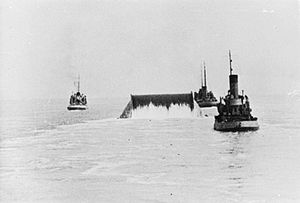
Operation Pluto (Pipeline Under the Ocean or Pipeline Underwater Transportation of Oil, also written Operation PLUTO) was an operation by British engineers, oil companies and the British Armed Forces to build submarine oil pipelines under the English Channel to support Operation Overlord, the Allied invasion of Normandy during the Second World War.
The British War Office estimated that petrol, oil, and lubricants would account for more than 60 per cent of the weight of supplies required by the expeditionary forces. Pipelines would reduce the need for coastal tankers, which could be hindered by bad weather, were subject to air attack, and needed to be offloaded into vulnerable storage tanks ashore. A new kind of pipeline was required that could be rapidly deployed. Two types were developed, named "Hais" and "Hamel" after their inventors. Two pipeline systems were laid, each connected by camouflaged pumping stations to the Avonmouth-Thames pipeline. (Full article...)
Selected article 44
Portal:Energy/Selected article/44

The Organization of the Petroleum Exporting Countries (OPEC, /ˈoʊpɛk/ OH-pek) is an organization enabling the co-operation of leading oil-producing and oil-dependent countries in order to collectively influence the global oil market and maximize profit. It was founded on 14 September 1960 in Baghdad by the first five members (Iran, Iraq, Kuwait, Saudi Arabia, and Venezuela). The organization, which currently comprises 12 member countries, accounted for an estimated 30 percent of global oil production. A 2022 report further details that OPEC member countries were responsible for approximately 38 percent of it. Additionally, it is estimated that 79.5 percent of the world's proven oil reserves are located within OPEC nations, with the Middle East alone accounting for 67.2 percent of OPEC's total reserves.
In a series of steps in the 1960s and 1970s, OPEC restructured the global system of oil production in favor of oil-producing states and away from an oligopoly of dominant Anglo-American oil firms (the "Seven Sisters"). In the 1970s, restrictions in oil production led to a dramatic rise in oil prices with long-lasting and far-reaching consequences for the global economy. Since the 1980s, OPEC has had a limited impact on world oil-supply and oil-price stability, as there is frequent cheating by members on their commitments to one another, and as member commitments reflect what they would do even in the absence of OPEC. However, since 2020, OPEC countries along with non-OPEC participants had helped in stabilising oil markets after the COVID-19 pandemic resulted in a collapse in oil demand. This has allowed oil markets to remain stable relative to other energy markets that experienced unprecedented volatility. (Full article...)
Selected article 45
Portal:Energy/Selected article/45
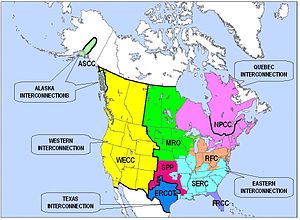
Hydro-Québec's electricity transmission system (also known as the Quebec interconnection) is an international electric power transmission system centred in Quebec, Canada. The system pioneered the use of very high voltage 735-kilovolt (kV) alternating current (AC) power lines that link the population centres of Montreal and Quebec City to distant hydroelectric power stations like the Daniel-Johnson Dam and the James Bay Project in northwestern Quebec and the Churchill Falls Generating Station in Labrador (which is not part of the Quebec interconnection).
The system contains more than 34,187 kilometres (21,243 mi) of lines and 530 electrical substations. It is managed by Hydro-Québec TransÉnergie, a division of the crown corporation Hydro-Québec and is part of the Northeast Power Coordinating Council. It has 17 interconnectors with the systems in Ontario, Newfoundland and Labrador, New Brunswick, and the Northeastern United States, and features 6,025 megawatts (MW) of interconnector import capacity and 7,974 MW of interconnector export capacity. (Full article...)
Selected article 46
Portal:Energy/Selected article/46

As farmers worldwide respond to higher crop prices in order to maintain the global food supply-and-demand balance, pristine lands are cleared to replace the food crops that were diverted elsewhere to biofuels' production. Because natural lands, such as rainforests and grasslands, store carbon in their soil and biomass as plants grow each year, clearance of wilderness for new farms translates to a net increase in greenhouse gas emissions. Due to this off-site change in the carbon stock of the soil and the biomass, indirect land use change has consequences in the greenhouse gas (GHG) balance of a biofuel. (Full article...)
Selected article 47
Portal:Energy/Selected article/47
The IRT Powerhouse, also known as the Interborough Rapid Transit Company Powerhouse, is a former power station of the Interborough Rapid Transit Company (IRT), which operated the New York City Subway's first line. The building fills a block bounded by 58th Street, 59th Street, Eleventh Avenue, and Twelfth Avenue in the Hell's Kitchen and Riverside South neighborhoods of Manhattan.
The IRT Powerhouse was designed in the Renaissance Revival style by Stanford White, an architect working with the firm McKim, Mead & White, and was intended to serve as an aboveground focal point for the IRT. The facade is made of granite, brick, and terracotta, incorporating extensive ornamentation. The interiors were designed by engineers John van Vleck, Lewis B. Stillwell, and S. L. F. Deyo. At its peak, the powerhouse could generate more than 100,000 horsepower (75,000 kW). (Full article...)
Selected article 48
Portal:Energy/Selected article/48
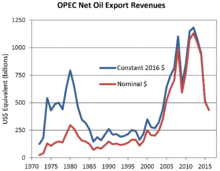
Petrodollar recycling is the international spending or investment of a country's revenues from petroleum exports ("petrodollars"). It generally refers to the phenomenon of major petroleum-exporting states, mainly the OPEC members plus Russia and Norway, earning more money from the export of crude oil than they could efficiently invest in their own economies. The resulting global interdependencies and financial flows, from oil producers back to oil consumers, can reach a scale of hundreds of billions of U.S. dollars per year – including a wide range of transactions in a variety of currencies, some pegged to the U.S. dollar and some not. These flows are heavily influenced by government-level decisions regarding international investment and aid, with important consequences for both global finance and petroleum politics. The phenomenon is most pronounced during periods when the price of oil is historically high.
The term petrodollar was coined in the early 1970s during the oil crisis, and the first major petrodollar surge (1974–1981) resulted in more financial complications than the second (2005–2014). (Full article...)
Selected article 49
Portal:Energy/Selected article/49 Manresa Island is a former island located in Norwalk, Connecticut, at the mouth of Norwalk Harbor in the Long Island Sound. The earliest name for the landform was Boutons Island, which dates to 1664. By the 19th century, the island had been purchased by John H. Keyser, who lived there and cultivated rare vegetation. He built a causeway in 1860, connecting the island to the mainland of South Norwalk. This gave rise to the name Keyser Island, which was sold to the Jesuits toward the end of the century.
In the 1950s, Connecticut Light & Power constructed a coal-fired power plant on the land. Over the years, the company filled in much of the tidal flats surrounding the island with coal ash, greatly increasing the size of the island from its original 23 acres (9.3 hectares) to 144 acres (58 hectares), and leading to significant ground pollution. In 1972, the plant was converted to burn fuel oil, and an oil spill occurred, damaging the surrounding environment. The plant was sold to NRG Energy in 1999, and was severely damaged by Hurricane Sandy in 2012, leading to its permanent closure in 2013. A portion of the land today is an undeveloped and ecologically important marine habitat. (Full article...)
Selected article 50
Portal:Energy/Selected article/50
The Stella power stations were a pair of now-demolished coal-fired power stations in the North East of England that were a landmark in the Tyne valley for over 40 years. The stations stood on either side of a bend of the River Tyne: Stella South power station, the larger, near Blaydon in Gateshead, and Stella North power station near Lemington in Newcastle. Their name originated from the nearby Stella Hall, a manor house close to Stella South that by the time of their construction had been demolished and replaced by a housing estate. They operated from shortly after the nationalisation of the British electrical supply industry until two years after the Electricity Act of 1989, when the industry passed into the private sector.
These sister stations were of similar design and were built, opened, and closed together. Stella South, with a generating capacity of 300 megawatts (MW), was built on the site of the Blaydon Races, and Stella North, with a capacity of 240 MW, on that of the former Lemington Hall. They powered local homes and the many heavy industries of Tyne and Wear, Northumberland and County Durham. The large buildings, chimneys and cooling towers were visible from afar. Their operation required coal trains on both sides of the river to supply them with fuel and river traffic by flat iron barges to dump ash in the North Sea. After their closure in 1991, they were demolished in stages between 1992 and 1997. Following the stations' demolition, the sites underwent redevelopment: the North site into a large business and industrial park, the South into a housing estate. (Full article...)

























